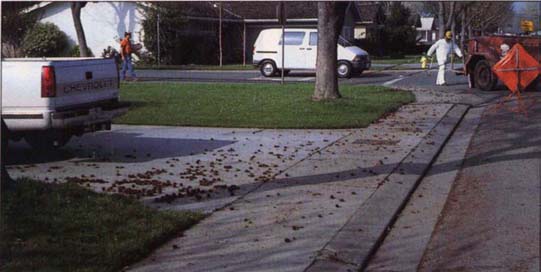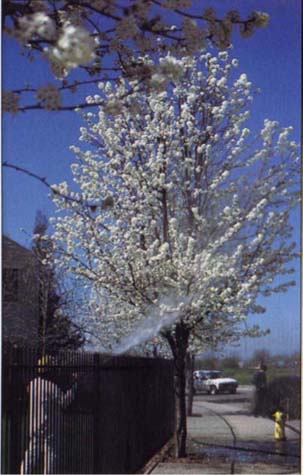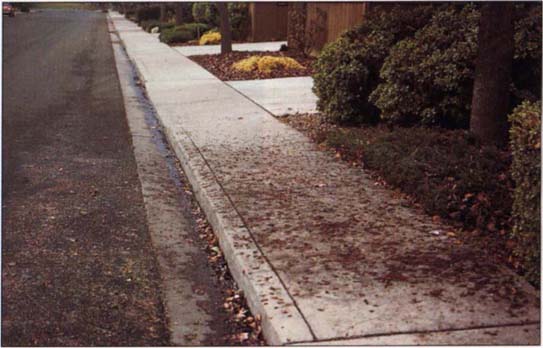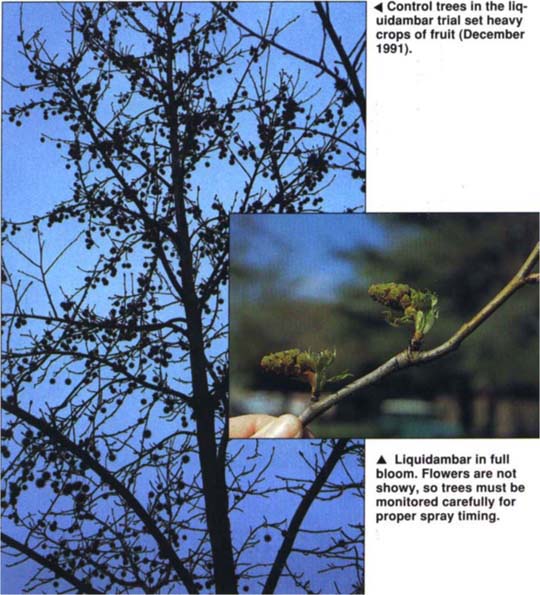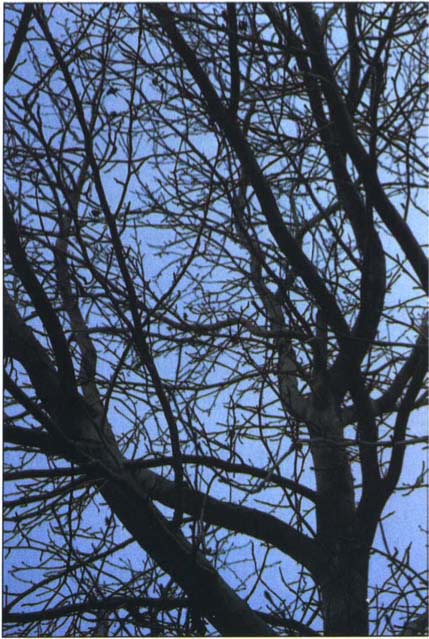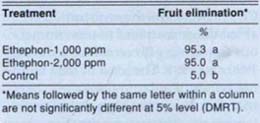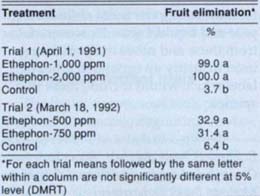All Issues
Ethephon sprays eliminate the messy, hazardous fruits of flowering pear and liquidambar
Publication Information
California Agriculture 48(2):21-24.
Published March 01, 1994
PDF | Citation | Permissions
Abstract
Two commonly planted street trees—flowering pear and liquidambar—produce heavy crops of fruits that are not only unsightly, but also create slippery sidewalks. Trials have now shown that almost all of the fruits of both species can be eliminated by telephone sprays applied at full bloom.
Full text
Ornamental flowering pear (Pyrus calleryana) and American sweetgum or liquidambar (Liquidambar styraciflua) are common landscape trees in California. They are planted for their beauty and other desirable features, but their fruits are hazardous, especially on streets, sidewalks and driveways. The ‘Aristocrat’ cultivar of flowering pear is especially fruitful.
In cities where these species are planted as street trees, parks departments have to deal with numerous complaints from pedestrians about the unsightly mass of crushed slippery fruits that fall from the trees. And if the trees are growing in city easements, the city is liable for any injuries the nuisance fruits cause.
Both liquidambar and flowering pear produce fruits that hang in the trees throughout the winter and fall in great number in early spring. Liquidambar produce golf ball-sized spiny fruits. The fruits of the flowering pear are small, round and inedible. They attract flocks of cedar waxwings, robins and other birds, which leave copious droppings, a major cause of citizen complaints. Flowering pear trees also often become heavily infested with broad-leaved mistletoe, as the pear fruits attract birds carrying mistletoe seed from other locations. Controlling the mistletoe is another parks department expense.
Ethephon spray being applied to ‘Aristocrat’ flowering pear at full bloom, the optimum application time (March 1989).
An ‘Aristocrat’ flowering pear has littered the sidewalk and street with its crushed fruit, rendering the area slippery and unsightly (January 1991).
In California, the plant growth-regulating chemical ethephon (Monterey Florel Brand Fruit Eliminator, Rhone-Poulenc Ag Co.) is currently registered for eliminating the nuisance fruits of apple, crab apple, carob and olive. When applied to plants, ethephon releases ethylene, a gas that causes abscission layers (layers of cells) to form between the small fruits and stems; this causes the fruit to drop before it can successfully set. In response to requests from landscape maintenance gardeners and city parks departments, we studied the efficacy of ethephon in preventing flowering pear and liquidambar trees from producing the nuisance fruits, looking for the optimum ethephon concentration and any phytotoxic reactions.
Street tree trials
We conducted trials in 1989,1991 and 1992 on heavy-fruit-producing mature trees (over 10 years old) being maintained as street trees by the City of Modesto Parks Department in Modesto, California.
In the flowering pear trial, our treatments consisted of ethephon at 1,000 and 2,000 ppm, and an untreated control. The 1,000 ppm treatment represents the standard label rate for eliminating fruit in olive and the high label rate for eliminating fruit in apple and crab apple. Spray treatments were made on March 15,1989, during full bloom; temperatures at the time of treatment were 55° to 60°F. Trees were sprayed to runoff, using approximately 10 gallons of mixed material per tree. A 500-gallon Bean sprayer was used to apply the sprays. This trial consisted of seven single tree replications per treatment.
We conducted two trials on liquidambar. In Trial 1, treatments consisted of ethephon at 1,000 and 2,000 ppm, and an untreated control. Spray treatments were made on April 1, 1991, at full bloom; newly emerging leaves (1/4 to 1/2 inch long) were present at the time of treatment; temperatures at the time of treatment were 58° to 60°F. As in the flowering pear trial, trees were sprayed to runoff, using approximately 10 gallons of mixed material per tree. Trial 1 consisted of 10 single tree replications per treatment.
In Trial 2, treatments consisted of ethephon at 500 and 750 ppm, and an untreated control. Sprays were applied on March 18,1992, at full bloom; newly emerging leaves (1/4 to 1/2 inch long) were present; temperatures were 60° to 65°F. Trial 2 consisted of seven single tree replications per treatment.
We evaluated the effectiveness of the flowering pear treatments on May 10,1989, when the fruits matured. Because foliage hid the green-brown fruits of the liquidambar, we had to wait until nearly complete leaf drop to properly evaluate the liquidambar trials: Trial 1 treatments were evaluated on December 6,1991; Trial 2 treatments on December 15,1992. We counted the number of fruits on five secondary lateral branches, selected randomly, in each of the trees in the test plots. Then we calculated the average number of fruits for each treatment. From counts made at the same time on untreated trees, we determined that liquidambars at this site had an average of 46 fruits per secondary lateral branch, and flowering pears had an average of 296 fruit per secondary lateral branch. Dividing the test plot averages by these baseline figures gave us the percentage of fruit remaining in test trees; subtracting the percentage of fruit remaining in test trees from 100 gave us the percentage of fruit eliminated.
Control trees in the liquidambar trial set heavy crops of fruit (December 1991).Liquidambar in full bloom. Flowers are not showy, so trees must be monitored carefully for proper spray timing.
Optimum spray rates
Ethephon at both 1,000 and 2,000 ppm was effective in eliminating the fruits of flowering pear (table 1) and liquidambar (table 2, Trial 1); at least 95% of the fruits were eliminated in both species, leaving insignificant amounts of fruit in the treated trees. The lower rates of ethephon, 500 ppm and 750 ppm, sprayed on the Trial 2 liquidambars reduced fruit set significantly compared with the untreated control trees (table 2, Trial 2), but still eliminated only 32.9% and 31.4% of the fruit, leaving unacceptable amounts of fruit in the trees.
We observed the test trees closely three or four times before evaluating the fruit elimination, and again the following spring after shoots began to grow. The ethephon treatments did not cause observable phytotoxicity to either the flowering pear or liquidambar; there were no visible differences in leaf growth or color between treated and control trees. Also, the ethephon sprays caused no premature blossom drop. This is an especially important result for the flowering pear, which is often planted for its showy bloom.
No visible phytotoxicity on the plants growing beneath or near the treated trees, and therefore contacted by spray drift, was noted at any time. Turfgrass species on the treated sites included Kentucky bluegrass (Poa pratensis), perennial ryegrass (Lolium perenne) and common Bermudagrass (Cynodon dactylon); woody plants included almond (Prunus dulcis), juniper (Juniperus spp.), laurustinus (Viburnum tinus) and photinia (Photinia × fraseri).
Spray timing
Timing ethephon sprays correctly is critical to eliminating the fruits. Flowering pears produce complete flowers that bloom over a period of 10 days to 2 weeks. To be effective on flowering pears, ethephon sprays must be applied early in the full bloom period, prior to fruit set; the sprays will not be effective later on, once the fruit begins to develop. Ethephon prevents fruit set, but does not eliminate flowers nor affect the duration of bloom in flowering pears. Complete spray coverage is also important, as flowers not contacted by the ethephon will successfully set fruit.
Determining when full bloom occurs for liquidambar is difficult, since the trees produce monoecious flowers that have no petals. Applying ethephon as new leaves begin to emerge has provided effective fruit elimination without damaging foliage.
Special registration
In 1990, the City of Modesto Parks Department applied for and was granted a California Special Local Needs Registration (24-C) allowing it to use ethephon on flowering pear for fruit elimination. Valid only within the City of Modesto, the registration enabled the department to treat numerous flowering pear street trees during 1990 and 1991. The level of fruit elimination was similar to that in our 1989 trial, but due to the high cost of maintaining the registration, the City of Modesto has since allowed it to expire.
Ethephon is not currently registered for eliminating the fruits of flowering pear and liquidambar. However, data from these and other trials are being used to justify an expanded ethephon label which would include these two species.



